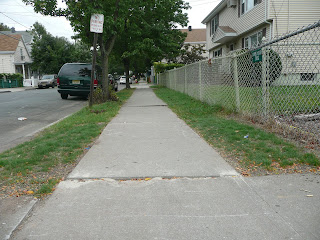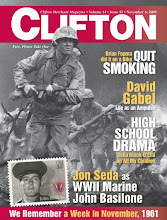By Jack De VriesOn Sept. 21, the fans came for one last time… to sit under its white façade, walk on its warning track, and visit its ghosts. They came to Yankee Stadium on Sept. 21 to see one more win – a 7-3 victory over the Baltimore Orioles – and take with them as many memories as they could.
During this final game, they cheered one last time for their heroes, past and present, in “the House That Ruth Built.” They breathed the smells of the great stadium. They ran their hands over the concrete walls, saying farewell to an old friend.
And, one last time, they looked out on the emerald grass and brown dirt field, taking a mental photo to last a lifetime.
The great Yankee Stadium, an arena second only to the Coliseum in Rome, will soon be no more.
And when it’s gone, Clifton loses a bit of its own past.
Yankee Stadium, which opened April 18, 1923, is just 12 miles from the city. For generations, Cliftonites have made the trip over the George Washington Bridge and up the Major Deegan Expressway to the stadium.
Sal Sperlazzi, 94, then of Passaic, took another route to Yankee Stadium to see Babe Ruth, Lou Gehrig and others.
“As a kid, I’d hitchhike down Paterson Plank Road to the ferry,” he says, “cross the river and take the subway up. I’d sit in the bleachers ’cause we didn’t have money in those days. We’d get home the same way.”
While fans have memories of the stadium, the Yankees have their own remembrances of Clifton.
The builder of Yankee Stadium, team owner Col. Jacob Ruppert, loved hosting beefsteaks in his brewery, catered by Clifton’s legendary beefsteak inventor, Hap Nightingale. Later, many Yankee stars, including Joe DiMaggio, Mickey Mantle, and Yogi Berra, would also enjoy a Nightingale beefsteak.
But Clifton’s history with the Yankees goes beyond food – back to the time of the stadium’s birth.
David vs. GoliathIn 1923 – just 11 days after Yankee Stadium opened – Babe Ruth and the Yankees journeyed to Clifton to play an exhibition game against the Doherty Silk Sox, arguably the greatest white semi pro baseball team in the country.
When Yankees manager Miller Huggins told his players about the Clifton game, the Babe was quoted as saying, “Fine. That is one ball park I like to play on.”
He wasn’t kidding. Twice as a member of the Boston Red Sox, Ruth played at the Doherty Oval behind the large mill on Main Ave., earning $5 from owner Harry Doherty for a home run. Wanting more prize money, Babe looked forward to his game in Clifton.
On April 29, 1923, he earned another $5… and caused a riot.
With the Yankees leading 9-6 in the ninth, Babe whacked a majestic home run that traveled nearly 500 feet over the Oval’s fence and beyond, bouncing onto the Erie Railroad tracks. The homer so thrilled the 15,000 fans that they rushed the field to personally congratulate Ruth… who had to be rescued by police.
The next year, the Silk Sox got their revenge as pitcher Harry Harper clouted a ninth inning homer to beat Ruth and the Yankees, 6-5.
It was the last time the teams would play against each other but not their final meeting.
Throughout the following decades, the Yankees continued their relationship with Clifton – the most famous being with the opening of a 40-lane bowling alley in the Styertowne Shipping Mall on April 28, 1958, owned by future Hall of Fame players Phil Rizzuto and Yogi Berra. Many of their Yankees teammates were frequent guests.
But there is one date that unites Clifton to Yankee Stadium forever – the celebration of “Clifton Day” at the stadium 41 years ago. The event, attended by more than 4,000 Clifton fans, was part of the city’s “Golden Jubilee,” recognizing Clifton’s first 50 years of existence.
Traffic Jams and Mantle BlastsThe Clifton Day celebration took place April 30, 1967, during the Yankees’ doubleheader against the California Angels. Heading into the date, New York was 8-5 and just a half game out of first place. Unfortunately, the Yanks would finish that year in ninth place at 72-90 – its once great dynasty old and crumbling.
But on that beautiful April day, the future of the team, city, and stadium looked promising.
Clifton’s famous crooner Frankie Randall (who cancelled appearances on English TV to be part of the festivities) would sing the National Anthem, Clifton Mayor Joseph Vanecek was to throw out the first ball, and the famous Clifton Mustangs Marching Band was scheduled to perform the Star Spangled Banner, as well as entertain between games.
Also planned by Clifton Day organizer Terry LaCorte was a reunion of the Doherty Silk Sox – most who had not seen each other since they battled Babe’s Yankees in the 1920s.
However, some of the festivities never took place.
Vanecek arrived at the stadium on-time, but many of the Clifton fans – journeying to the stadium on 30 chartered buses – got stuck in a massive traffic jam on the Major Deegan. So did the Marching Mustangs, traveling in four buses of their own.
The entire contingent arrived 15 minutes after the game started, with Randall missing his chance to sing.
“Clifton Day is a happy memory today,” says LaCorte, “but I wasn’t too happy back then with the traffic.”
But the day quickly improved, especially on the field. In the first game, Clifton fans watched as Mickey Mantle smacked a home run, the 498th of his career, off Angels’ pitcher Minnie Rojas, to power New York to a 4-1 win. Fans also saw Whitey Ford pitch one-run ball over seven innings, with reliever Dooley Womack getting the victory.
Between games, Vanecek and Randall were interviewed on TV by Yankees broadcaster Rizzuto.
“That was such a thrill for me,” says Randall, “because guys like DiMaggio, Rizzuto, Berra, and (Tommy) Henrich were my idols growing up.
“When I was asked to perform at Yankee Stadium, I couldn’t say no. Though I did miss singing there, it was still a great day – they took me in the dugout and in the press box, a real nice tour. Clifton Day became one of the most exciting times in my life.”
On the field, the Silk Sox held their reunion with players like Clifton’s “Bibbs” Raymond and Benny Borgmann in attendance.
Ironically, Raymond was once signed by the Yankees and went to spring training with the club in 1925. Later that season, he “jumped’ the team to go back and play with the Silk Sox. A combination of homesickness and not being able to break into the starting line-up caused Raymond to return to Clifton – something that angered the Yankees, who believed Bibbs had a future with the club.
Borgmann had his own history at Yankee Stadium. In the 1920s while a member of the Silk Sox, he tried out on the field and was offered a contract with the Boston Red Sox, in town to play the Yankees.
However, Borgmann, who would eventually be inducted into the Basketball Hall of Fame, refused to report to spring training so that he could complete his lucrative basketball season. For his actions, Commissioner Kenesaw Mountain Landis banned him from organized baseball, and it took Borgmann years to earn his reinstatement.
But on that special day at Yankee Stadium, all was forgotten by Borgmann and Raymond, who watched the game from the mayor’s box. Between games, memories were made for the 145 Marching Mustangs, led by drum majorette Barbara Williams and Jubilee pageant beauty queen Susan Sisco.
Behind a banner that read, “Clifton Golden Jubilee – Fifty Years of Progress,” the Mustangs marched in formation to the center of the field where they performed five songs, including Peter Gunn. Each selection was announced by Yankee Stadium announcer Bob Sheppard.
The Herald-News reported, “All tunes were well-received by the audience.”
Besides the traffic, the only black mark on the day was the Yankees’ loss in the nightcap to the Angels, 4-2, with Mantle accounting for both New York runs with a two-run double.
Clifton Fans Say Good-ByeIn 1993, Brian Reilly saw his first Yankees game at age 10 with his Clifton Western Division Little League team. Since then, he’s been hooked.
“I became a big Don Mattingly fan,” Reilly, 25, says. “First, I got the pennant and then a Mattingly shirt. When I’d watch the Yankees on TV, I’d watch him.”
As he got older, Reilly began to watch Mattingly more at the stadium. “As soon as I got my license,” he says, “I started going to about 10 games a year.” At 19, Reilly took a big step as a Yankees fan – becoming one of the stadium’s legendary “Bleacher Creatures.”
“I have what I describe as ‘an emotional attachment’ to the Yankees,” Reilly says, “and a seat in Section 39 of the bleachers for the past six years.” Along with Clifton friends Joe and John Pecora, he attends about 20 games a year. Known for their game-starting “Roll Call” (the Bleacher Creatures chant each starting Yankees player’s name until he waves), Reilly and his fellow Creatures are famous for their serenades of opposing right fielders.
“If I was Trot Nixon,” Reilly laughs, “and I heard some of the songs we sing, I’d go home and cry.” A recent Montclair State University graduate who works at DeLuxe Formalwear on Main Ave., Reilly says his best moment came in the 2004 American League Championship Series Game 1 against the Boston Red Sox. “(Boston’s) Curt Schilling was pitching but we were doing the “Who’s your daddy?” chants to Pedro Martinez,” he says. “There was a point in the game when the Yankees had bases loaded and Hideki Matsui hit a single. Gary Sheffield slid, scored and pumped his fist in the air.
“We went crazy. I was there with my father and we started hugging strangers we were so happy. People were throwing $9 beers in the air – nobody cared if they got wet. It was incredible.”
When the Series turned sour and Boston came back from a 3-0 deficit, Reilly learned something about his girlfriend Krystina. “That’s when I saw she was a keeper,” he says. “I was so upset during the four games the Yankees lost, I’d leave the house without talking, just to take a walk. I couldn’t sleep for a week because I was so upset. But she stayed with me, even though we’d only been together for a little bit.”
On Sunday, Sept. 21, Reilly attended the last game at Yankee Stadium. “I told my friends that I needed to take my own car because I didn’t want anybody rushing me out that night,” he says.
“You could tell the game was going to be special – Spike Lee was in the bleachers filming us. I remember looking around and thinking that this was where Ruth, Gehrig and DiMaggio played.”
After the Yankees’ win, Reilly’s friends left, leaving him alone in the stadium with other diehard fans. “I walked around with my video camera,” he says, “taking pictures and trying to make the night last. I finally left at about 1:30 a.m.” Though he plans to attend games at the new Yankee Stadium next year, Reilly will never forget the old building. “You know,” he says, “they call Yankee Stadium a cathedral. And they’re right, it really is.”






_0405201.jpg)
